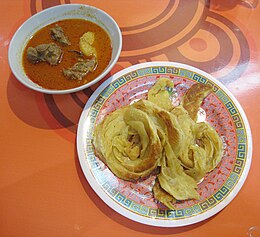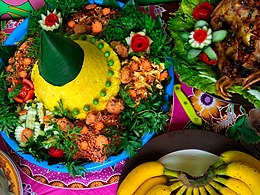Cuisine of the people of Indian-Indonesians
Roti canai mutton curry , Indian influence on Indonesian cuisine .Indian Indonesian cuisine (Indonesian : Masakan India-Indonesia Indian cuisine with local Indonesian-style . This cuisine consists of adaptations of authentic dishes from India , as well as original creations inspired by the diverse food culture of Indonesia . Indian influence can be observed in Indonesia as early as the 4th century. Following the spread of Islam to Indonesia and trading,[1] Muslim Indian as well as Arab influences[2] biryani ,[3] murtabak ,[4] [5] curry [6] paratha [7] Acehnese , Minangkabau ,[8] Malay , Palembangese , Betawi and Javanese cuisine .
History
This section needs expansion. You can help by
adding to it . (January 2024)
List of Indian Indonesian foods
This list also includes Indonesian dishes that has experienced of acculturation or assimilation to Indian cuisine .[9] [10]
Dishes
Apem cake of steamed dough made of rice flour , coconut milk , yeast and palm sugar , usually served with grated coconut.Ayam tandori yoghurt and cooked in a clay oven .Chapati flatbread originating from India, brought by the Indian immigrant to the country.Chutney condiments that usually contain some mixture of spices, vegetables or fruits. Chutneys may be either wet or dry, and can have a coarse to a fine texture.Dosa pancake dish.Gulai curry dish with main ingredients might be poultry, goat meat, beef, mutton, various kinds of offal, fish and seafood , and also vegetables such as cassava leaves and unripe jackfruit.Idli rice cake with patty-shaped. Most often eaten at breakfast or as snack. It usually served in pairs with chutney , sambar or other accompaniments.Kari ayam Kari domba Kari kambing Kari kepala ikan Kari udang Korma coconut milk or grated coconut.Laksa Mi aceh Acehnese curry noodle, it can be fried or soupy.Mi kari Mi rebus egg noodles in a sweet and spicy sauce , green chillies with a hard boiled egg.Martabak HAR , an egg-murtabak served in curry and topped with chillies in sweet-sour soy.Murtabak pancake or pan-fried bread, sometimes filled with beef and scallions.Naan flatbread . It is usually eaten with an array of sauces such as curries .Nasi biryani Nasi kari rice and curry .Nasi kabuli palaw pilaf rice dish, consists of steamed rice mixed with raisins, carrots, and beef or lamb.Nasi kebuli ghee . Usually served during Mawlid .Nasi megono , Indian-influenced Javanese rice dish with chopped young jackfruit mixed with coconut and other spices .Raita yogurt , together with raw or cooked vegetables, more seldom fruit, or in the case of boondi raita , with fried droplets of batter made from gram flour .Rendang Minangkabau .Roti canai paratha -like roti served with curry or other condiments.Roti tisu roti canai .Sambar lentil -based vegetable stew or chowder . Satti Sorru :Indian claypot riceSoto Soto betawi soto soup made of beef or beef offal, cooked in a cow milk or coconut milk broth and ghee , with fried potato and tomato.Tongseng stew dish in curry -like soup with vegetables and sweet soy sauce .
Snacks and desserts
Adhirasam Tamil cuisine .Cendol dessert that contains droplets of green rice flour jelly, coconut milk and palm sugar syrup.Halwa confectionery .Keripik pisang Keripik singkong Kheer pudding that made by boiling milk, sugar, and rice, tapioca, vermicelli or sweet corn.Kue laddu Kue modak Kue putu cake .Kue putu mayang string hoppers with palm sugar syrup mixed with coconut milk .Kue pinyaram Minangkabau traditional cake made from mixture of white sugar or palm sugar , white rice flour or black rice, and coconut milk.Samosa dumpling with a savoury filling, such as spiced potatoes, onions, peas, or lentils.
Beverages









